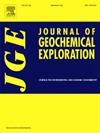REE-bearing phosphate mineral chemistry for iron sulfide‑copper‑gold exploration: A study at Jericho, NW Queensland, Australia
IF 3.4
2区 地球科学
Q1 GEOCHEMISTRY & GEOPHYSICS
引用次数: 0
Abstract
We present mineral chemistry data from the rare-earth element (REE) bearing phosphates monazite and rhabdophane sampled from the Jericho iron sulfide‑copper‑gold (ISCG) deposit in the Cloncurry District, north-west Queensland. REE-bearing phosphates sampled from within the narrow mineralised sequence have a characteristic mineralogy and chemical signature compared to REE-bearing phosphates sampled from the unmineralised metamorphic host sequences only meters away. The mineralised samples contain the hydrated REE-bearing phosphate rhabdophane (REEPO4 · n H2O) which occurs as veins and ‘spongy’ textured grains in association with sulfide minerals and commonly replacing apatite. In contrast, the metamorphic host rocks contain monazite (REEPO4) with metamorphic textures and are rarely associated with sulfide minerals. Rhabdophane and monazite have comparable ΣREE and REE profiles, however the rhabdophane grains are characterised by lower Th contents and higher Ca, S and water contents. Molar ratios of S/Th and Ca/Th, determined by electron probe microanalyser (EPMA), can be used to discriminate between REE phosphates from within the Jericho mineralisation from those not associated with mineralisation. The presence of hydrated rhabdophane also indicates the temperature of mineralisation is at or below 200–250 °C.
含 REE 的磷酸盐矿物化学用于硫化铁-铜-金勘探:澳大利亚昆士兰西北部杰里科研究
我们介绍了从昆士兰州西北部克隆库里区杰里科硫化铁-铜-金(ISCG)矿床采样的含稀土元素(REE)磷酸盐独居石和菱锰矿的矿物化学数据。在狭窄的成矿序列中取样的含 REE 磷酸盐与在数米之外未成矿的变质母岩序列中取样的含 REE 磷酸盐相比,具有独特的矿物学和化学特征。矿化样本中含有水合含 REE 磷酸盐的磷酸盐 rhabdophane(REEPO4 - n H2O),它以矿脉和 "海绵状 "纹理颗粒的形式出现,与硫化物矿物伴生,通常取代磷灰石。相比之下,变质主岩中的独居石(REEPO4)具有变质质地,很少与硫化物矿物伴生。斜长石和独居石具有相似的 ΣREE 和 REE 图谱,但斜长石晶粒的特征是 Th 含量较低,而 Ca、S 和水含量较高。通过电子探针显微分析仪(EPMA)测定的S/Th和Ca/Th摩尔比可用于区分杰里科矿化区内的REE磷酸盐和与矿化无关的磷酸盐。水合菱锰矿的存在也表明矿化温度在 200-250 ℃ 或以下。
本文章由计算机程序翻译,如有差异,请以英文原文为准。
求助全文
约1分钟内获得全文
求助全文
来源期刊

Journal of Geochemical Exploration
地学-地球化学与地球物理
CiteScore
7.40
自引率
7.70%
发文量
148
审稿时长
8.1 months
期刊介绍:
Journal of Geochemical Exploration is mostly dedicated to publication of original studies in exploration and environmental geochemistry and related topics.
Contributions considered of prevalent interest for the journal include researches based on the application of innovative methods to:
define the genesis and the evolution of mineral deposits including transfer of elements in large-scale mineralized areas.
analyze complex systems at the boundaries between bio-geochemistry, metal transport and mineral accumulation.
evaluate effects of historical mining activities on the surface environment.
trace pollutant sources and define their fate and transport models in the near-surface and surface environments involving solid, fluid and aerial matrices.
assess and quantify natural and technogenic radioactivity in the environment.
determine geochemical anomalies and set baseline reference values using compositional data analysis, multivariate statistics and geo-spatial analysis.
assess the impacts of anthropogenic contamination on ecosystems and human health at local and regional scale to prioritize and classify risks through deterministic and stochastic approaches.
Papers dedicated to the presentation of newly developed methods in analytical geochemistry to be applied in the field or in laboratory are also within the topics of interest for the journal.
 求助内容:
求助内容: 应助结果提醒方式:
应助结果提醒方式:


